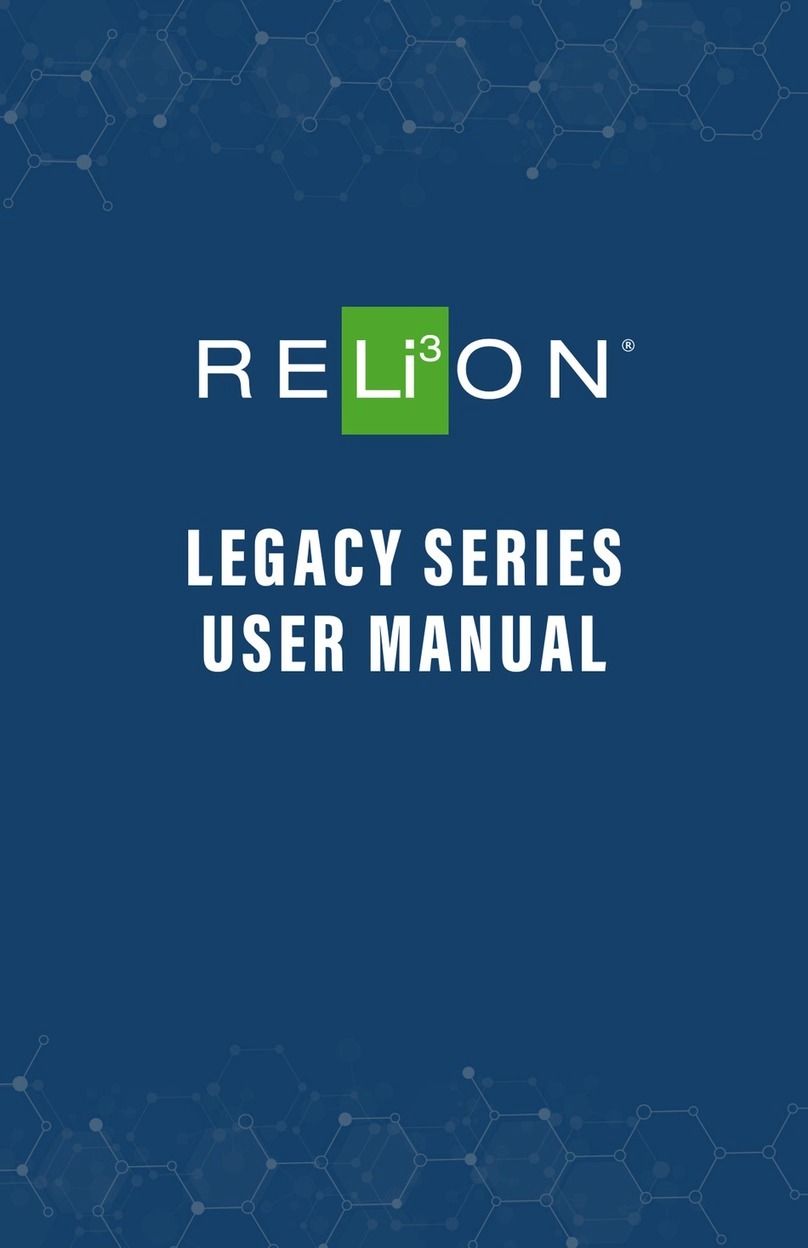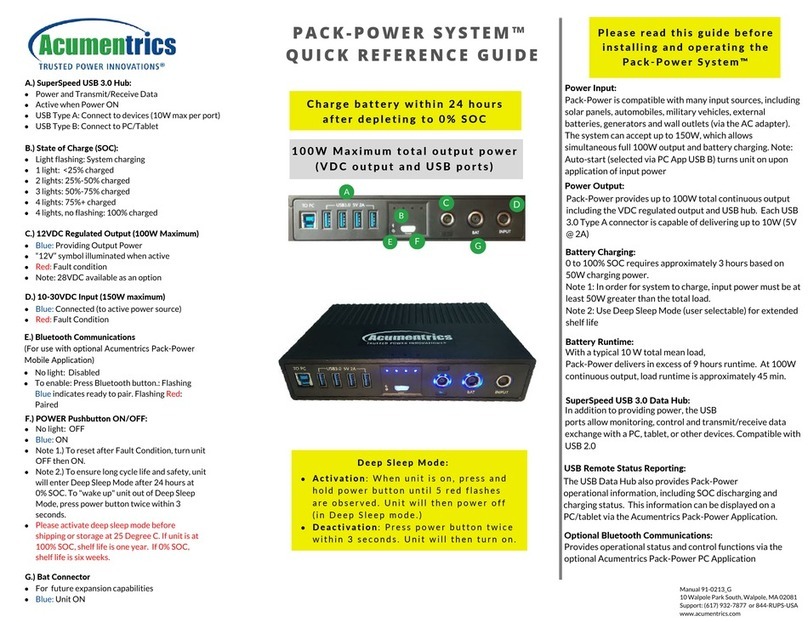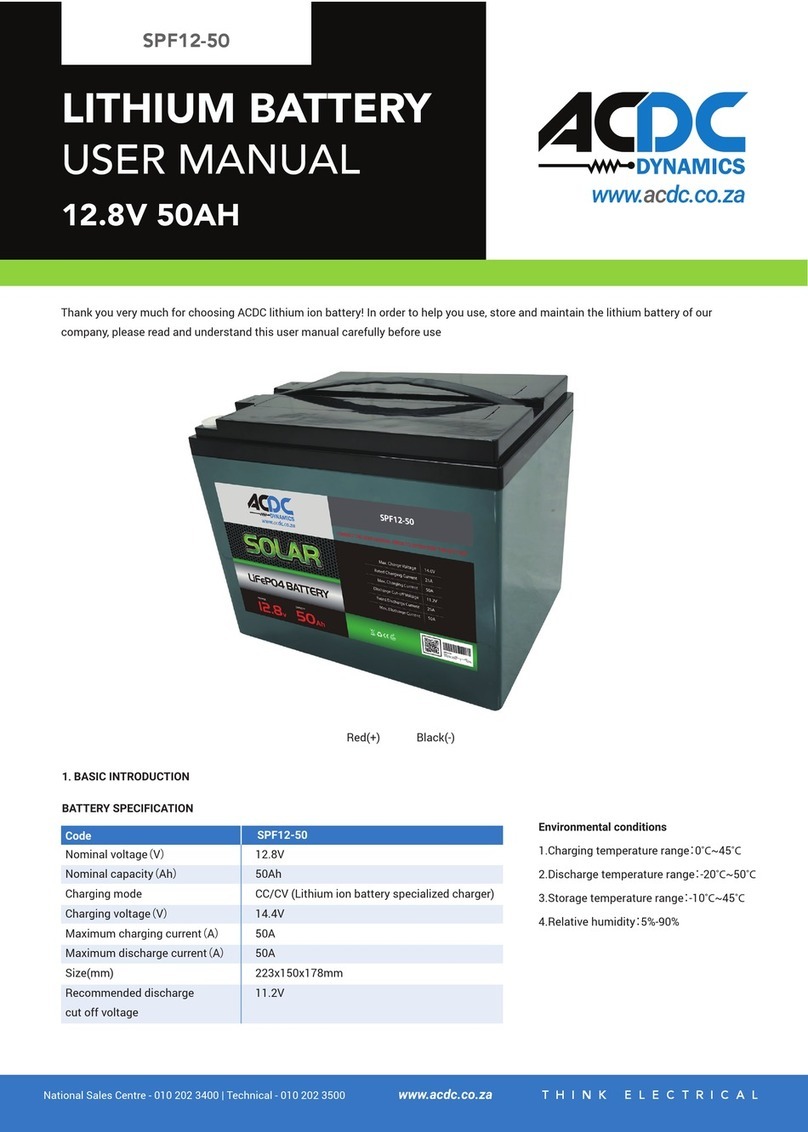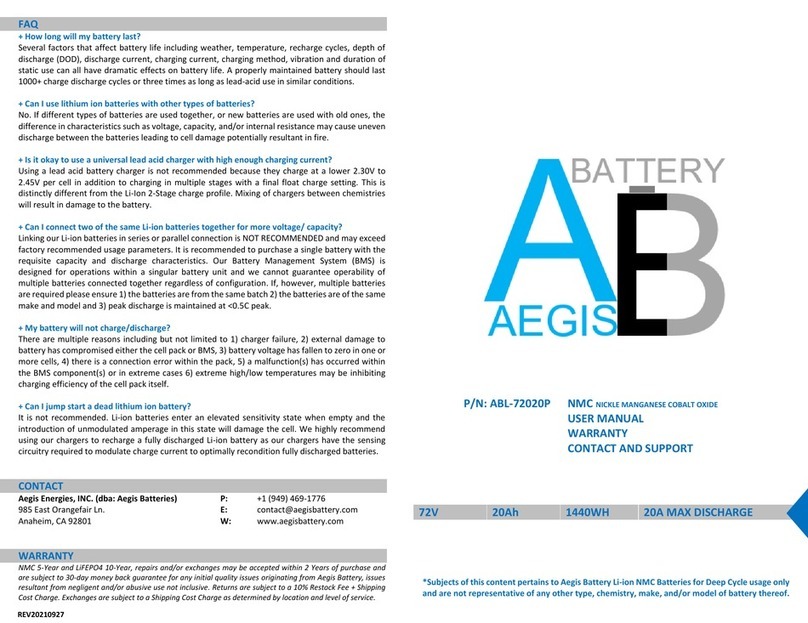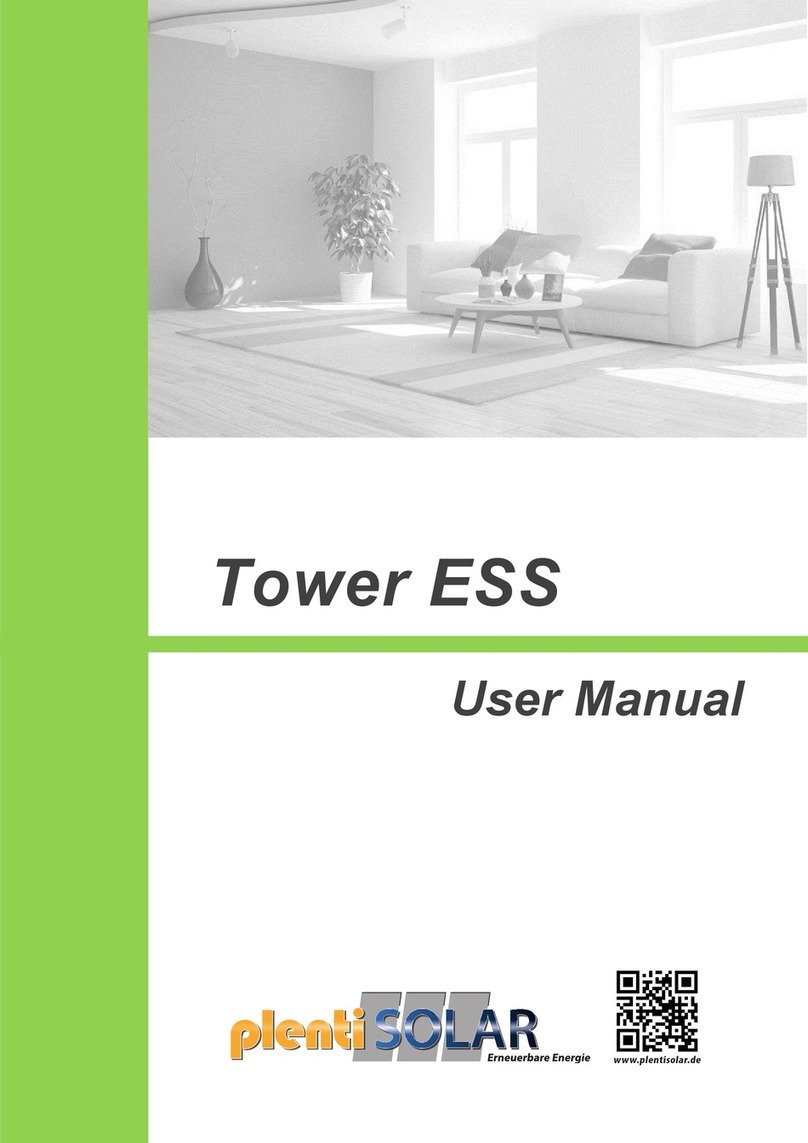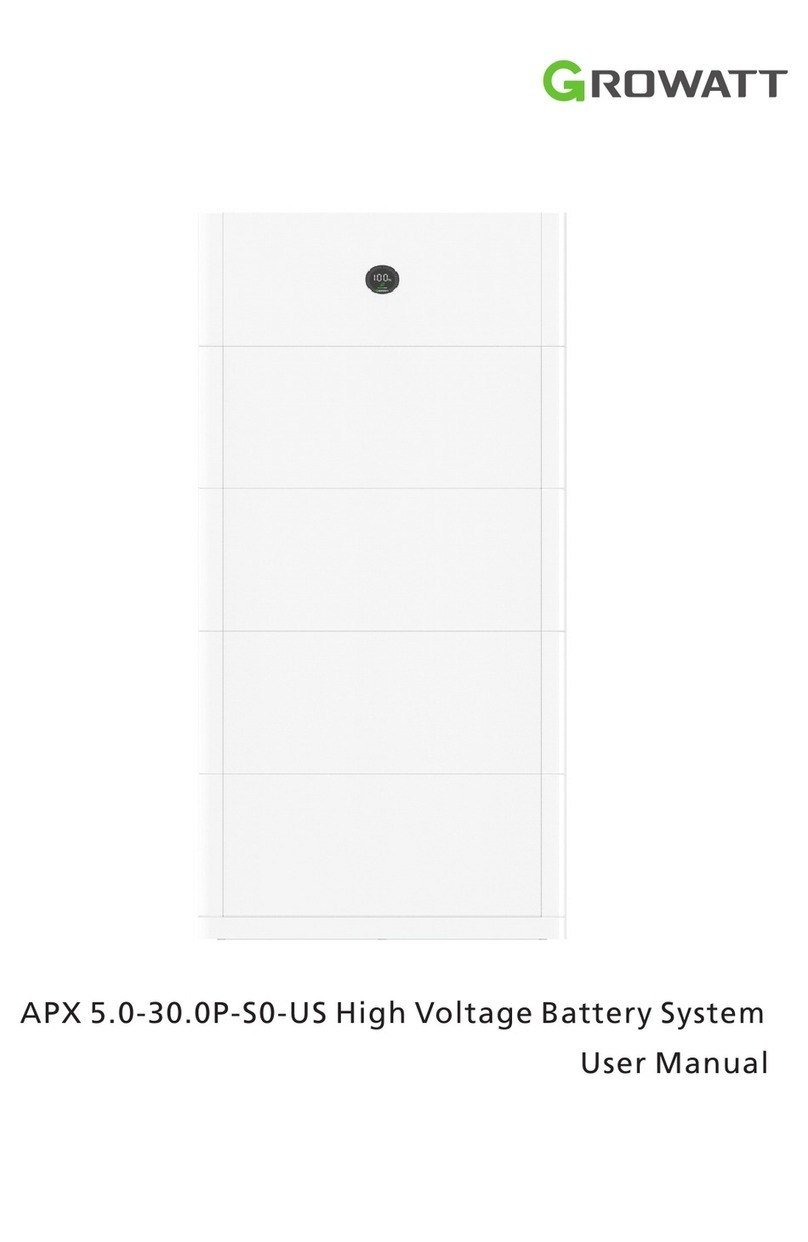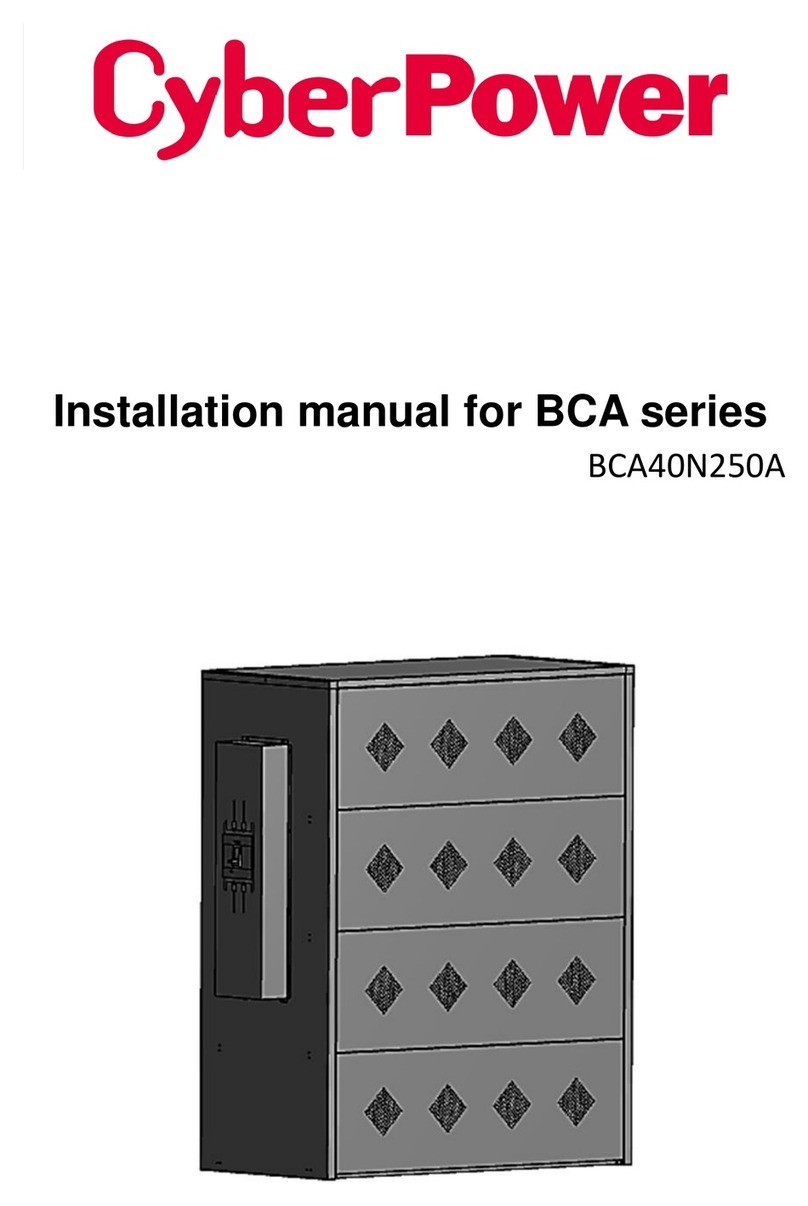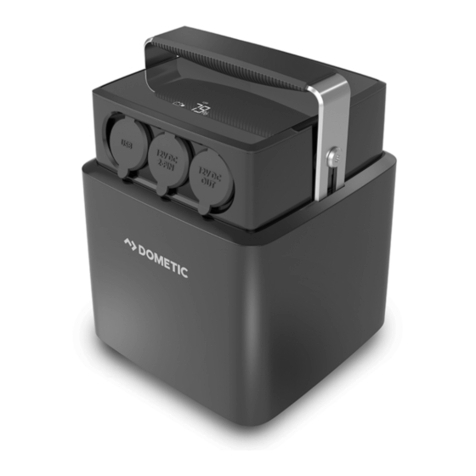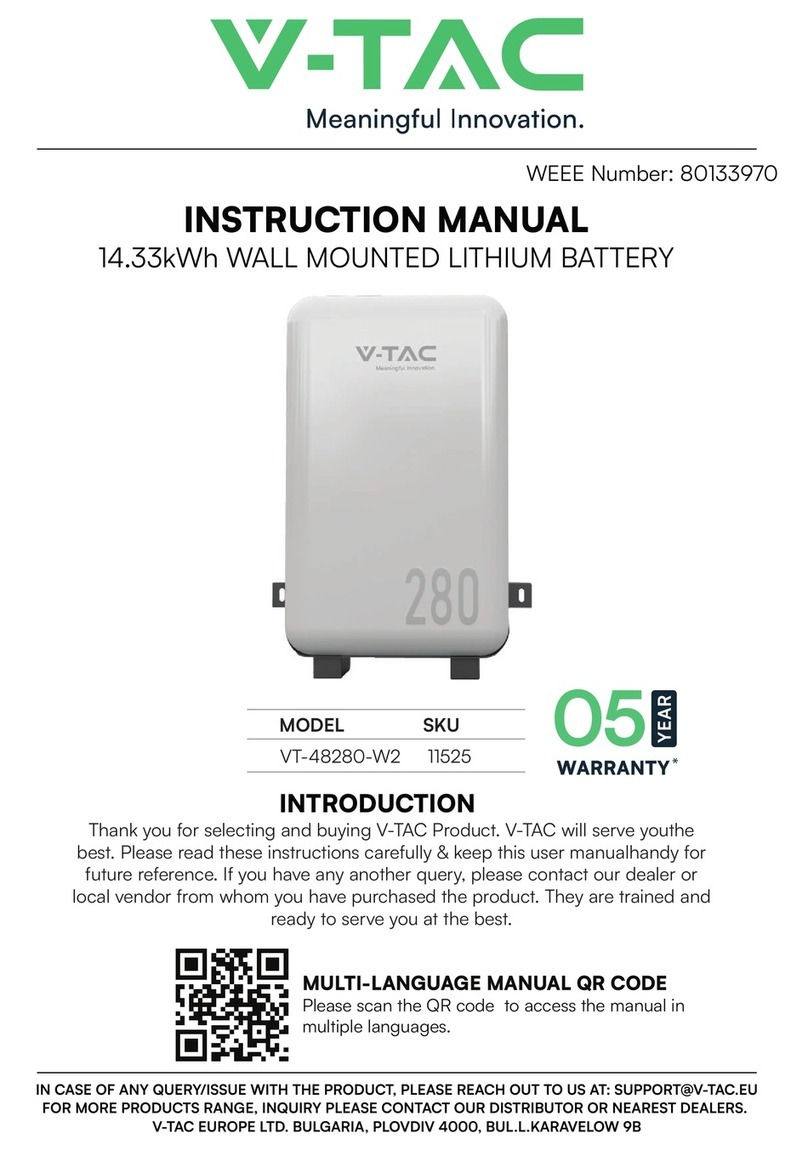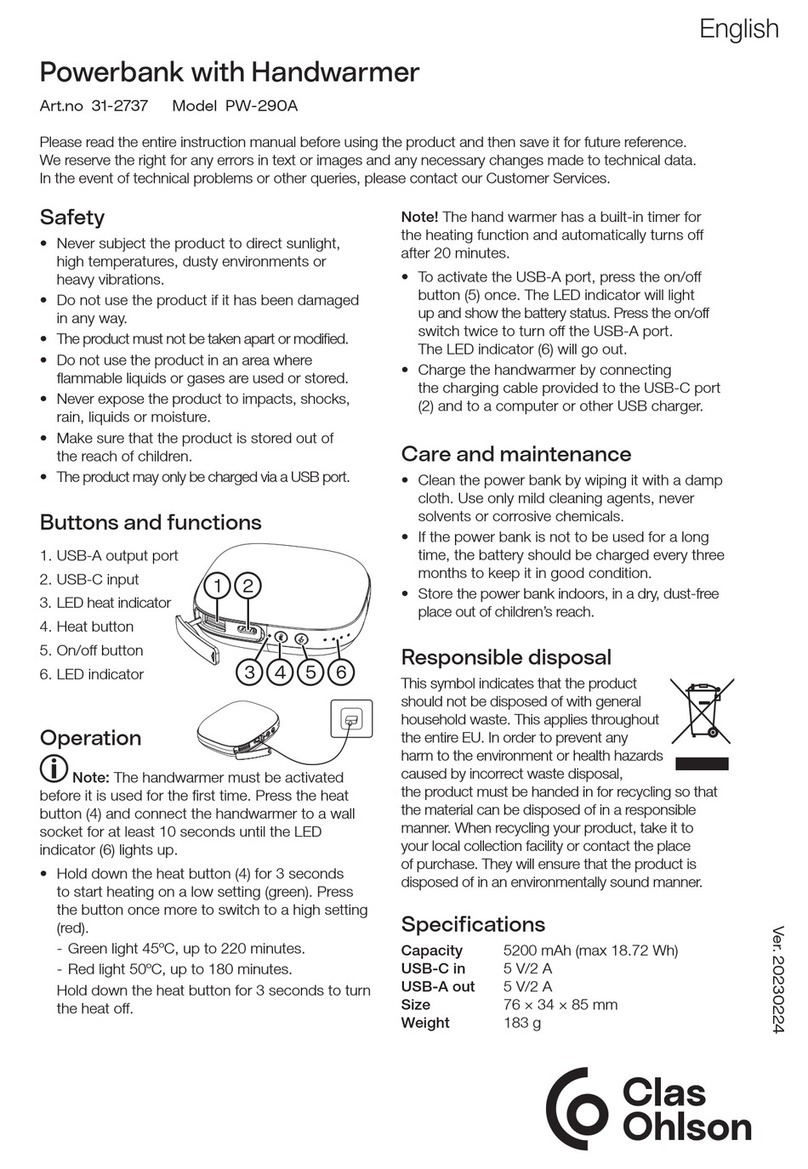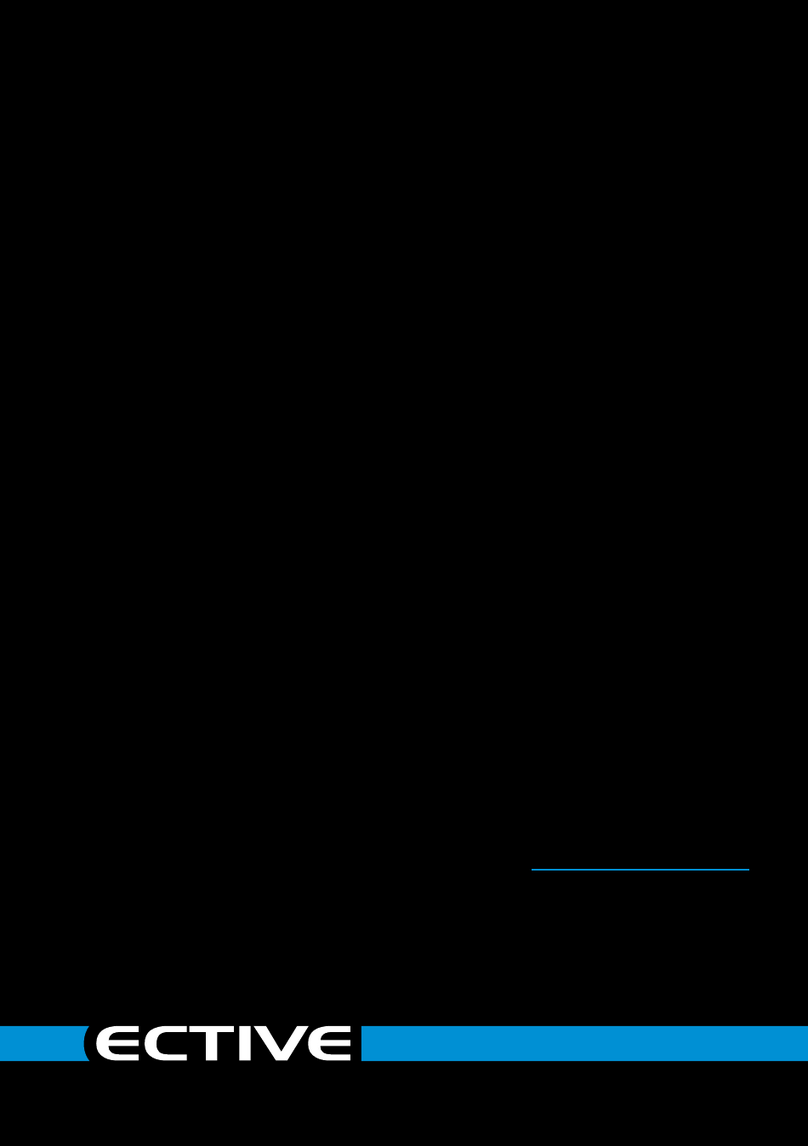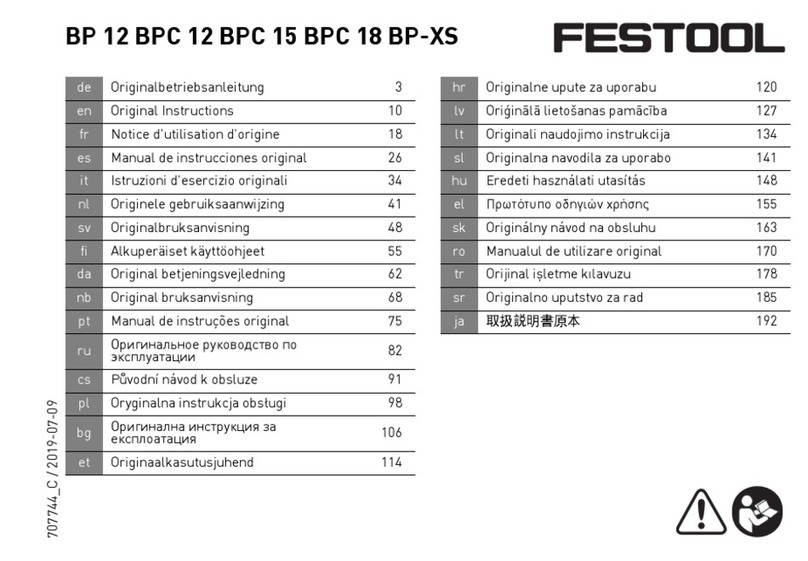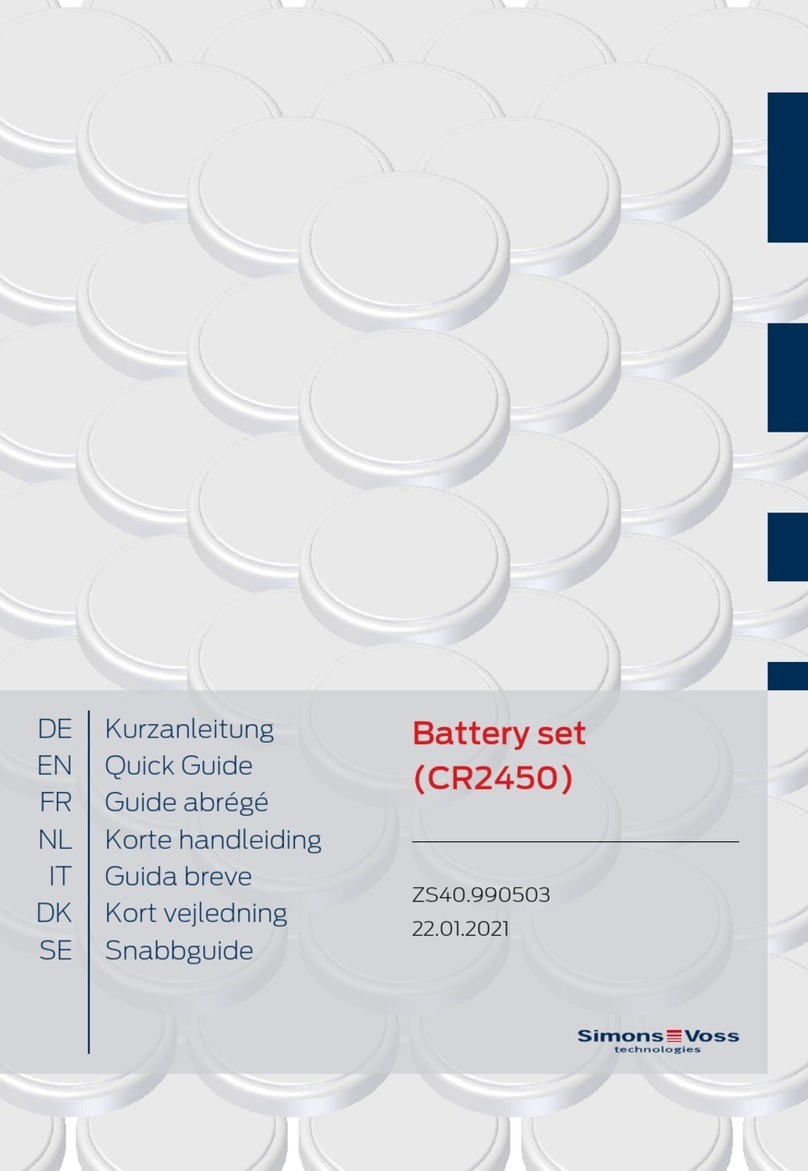ReliOn LiFePO4 Series User manual

RELIONBATTERY.COM • 855-931-2466 1
STANDARD PRODUCTS
USER MANUAL

2
Thank You
FOR CHOOSING

RELIONBATTERY.COM • 855-931-2466 3
YOUR PURCHASE
SUPPORTS OUR PLANET
As 1% for the Planet members, we donate 1% of our
revenue each year to non-profits solving the most
pressing environmental challenges of our time.

4
Relionbattery.com
TABLE OF
CONTENTS
Safety 6
Equipment
LiFePO4 Battery Basics 7
(vs. Lead-Acid)
Battery Installation 8
Battery Storage 10
Battery Discharging 10
Battery Charging 11
BMS Operation 12
Battery Recycling
Warranty Registration

RELIONBATTERY.COM • 855-931-2466 5
RELiON BATTERY
USER MANUAL
This User Manual was created by RELiON’s engineering
team and contains important information regarding the
proper care and maintenance of your lithium battery. This
manual only applies to RELiON Lithium Batteries. It does
not apply to other lithium batteries or chemistries. Please
read through the guide in detail before installing and
using your new battery. Reading this guide in its entirety
will help you achieve high performance and long life from
your lithium battery investment. Should you have any
questions concerning safety precautions, installation or
use of your lithium battery, please contact us at
powerpros@relionbattery.com or call 855-931-2466 (toll-
free) or +1 (803) 547-7288 (international).

6
. SAFETY
Lithium Iron Phosphate (LiFePO4) batteries are an inherently safe
chemistry. Please reference RELiON’s Lithium Iron Phosphate Safety
Document (available at relionbattery.com) for more details. However, as
with any electronics, safety measures should always be taken. Please
adhere to the instructions within this manual for safe handling and
operation.
• Always wear protective gear when handling batteries
• Use a wrench with a rubber coated handle
• Do not place any objects on top of batteries
• Do not place batteries on a metallic surface
• Check that all cables are in good condition
• Make sure all cable connections are properly tightened
• Install and remove batteries using the lifting handles provided
• Keep sparks, flames and metal objects away from batteries
• Have RELiON’s SDS on the premises
• Have an ABC extinguisher of the following type: a foam extinguisher,
CO2, ABC dry chemical, powdered graphite, copper powder or soda
(sodium carbonate) on the premises
This manual only applies to RELiON Lithium
Batteries. It does not apply to other lithium
batteries or chemistries.

RELIONBATTERY.COM • 855-931-2466 7
. EQUIPMENT
The following equipment may be required to install your battery:
• Protective Gear; gloves and eye protection
• Wrench with insulated/rubber coated handle
• Voltmeter
. LiFePO4 BATTERY BASICS
VS. LEADACID
3.1. Basic Construction
RELiON LiFePO4 battery packs include two main components:
1. Individual cells assembled inside a plastic or steel case
2. An internal BMS (Battery Management System) to protect the
battery from abusive operation
3.2. Cell and Battery Pack Voltages
Lithium Iron Phosphate
(LiFePO4) Nominal Voltage
Lead-Acid Equivalent
Nominal Voltage
Cell = 3.2V Cell = 2.0V
12.8V – 4 cells in series 12V
25.6V – 8 cells in series 24V
38.4V – 12 cells in series 36V
51.2V – 16 cells in series 48V

8
. BATTERY INSTALLATION
4.1. Battery Connections
To maximize the performance and to ensure safe operation of your battery,
use the appropriate cable size and tighten connections using the proper
torque value. Refer to the data sheet for your particular battery's torque
value. It is recommended to use a washer. Place the washer between the
cable lug and nut, not between the cable lug and battery terminal surface.
4.2. Cable Size
Choose the appropriate cable
size based on the expected
load of your system. See the
table below – ENEC 310.15 (B)
(16) – Allowable Ampacities for
copper cables rated at 167°F
(75°C) operating at an ambient
temperature of 86°F (30°C).
4.3. Torque Values
Terminal connections should
adhere to the appropriate
torque values for the specified terminal type to provide optimum electrical
conductivity. Refer to the data sheet for your particular battery's torque value.
Over- or under- tightening the connections can result in terminal breakage,
over-heating and/or terminal melting. Use a rubber handled or insulated
wrench when making terminal connections to avoid an external short circuit.
4.4. Terminal Protection
Battery terminals may be covered with a plastic cap to prevent an
external short circuit. Terminals must be covered with a protective cap or
non-conductive tape prior to battery disposal to a lithium recycler.
Wire Gauge (AWG) –
Copper Conductors
Ampacity
(Amps)
14 25
12 30
10 40
855
675
495
2130
1150
1/0 170
2/0 195
4/0 260

RELIONBATTERY.COM • 855-931-2466 9
4.5. Battery Orientation
Lithium batteries can be placed upright or on their sides.
4.6. Series or Parallel Connections
When connecting batteries in series or parallel, please follow these
guidelines:
(1) Make sure each battery is within 50mV (0.05V) of each other before
putting them in service. This will minimize the chance of imbalance
between batteries. If your batteries get out of balance, the voltage of any
battery is >50mV (0.05V) from another battery in the set, you should
charge each battery individually to rebalance.
(2) Size batteries in parallel accordingly: The capacity of batteries (rated
in amphours) when connected in parallel is increased by the multiple of
the batteries connected (2x, 3x, 4x, etc). However, the current ratings
(discharge and charge) for parallel batteries is only increased by 75% of
the multiple of the batteries connected (1.5x, 2.25x, 3x, etc).
(3) Batteries connected in series are best charged as individual batteries.
charging as a series bank can lead to imbalances and reduced runtime,
requiring an occasional individual balancing charge.
(4) Please reference RELiON’s LiFePO4 Charging Instructions document
(available on our website at relionbattery.com) for series and parallel
charging.
Specifications for Batteries in Parallel
Battery Quantity v 2 3 4
Voltage 12.8 12.8 12.8 12.8
Capacity (Ah) 100 200 300 400
Max Continuous Discharge
Current 100 150 225 300
Peak Discharge Current 200 300 450 600
Rec'd Charge Current 50 75 113 150
Max Charge Current 100 150 225 300

10
. BATTERY STORAGE
5.1. Storage Temperature
LiFePO4 can be stored between 23°F to 95°F (-5°C to 35°C).
For storage longer than 3 months, the recommended temperature
range is 32°F to 77°F (0°C to 25°C).
5.2. Storage Conditions
It is recommended to store LiFePO4 batteries at 50% state of charge
(SOC). If batteries are stored for long periods of time, cycle the batteries
at least every 6 months.
. BATTERY DISCHARGING
6.1. Discharge Temperature
Lithium Iron Phosphate batteries generate a fraction of the heat of other
lithium chemistries making them very safe. LiFePO4 batteries can safely
operate between -4°F to 140°F (-20°C to 60°C). All RELiON LiFePO4
come with a BMS that protects the battery from over-temperature. If the
BMS disconnects due to high temperature, wait until the temperature
reduces and the BMS reconnects the battery before using or charging the
battery. Please refer to your battery data sheet for BMS high temperature
cut-o value.
6.2. Discharging your LiFePO4 Battery
LiFePO4 batteries can be discharged up to 100% of their capacity.
However, to optimize the performance of your LiFePO4 battery, and
to avoid the BMS disconnecting the battery, we recommend limiting
the discharge to 80%. Please refer to your battery data sheet for the
continuous and peak rates of discharge for your specific battery model.
Other manuals for LiFePO4 Series
1
Table of contents
Other ReliOn Batteries Pack manuals
